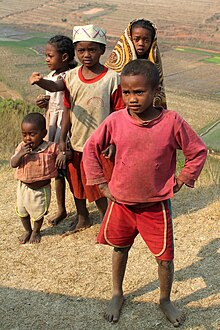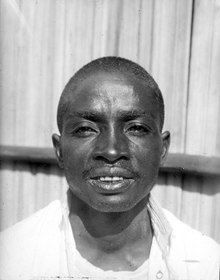| This article includes a list of general references, but it lacks sufficient corresponding inline citations. Please help to improve this article by introducing more precise citations. (August 2024) (Learn how and when to remove this message) |
 Betsileo children Betsileo children | |
| Total population | |
|---|---|
| c. 4.359 million | |
| Regions with significant populations | |
| Madagascar | |
| Languages | |
| Malagasy and French | |
| Related ethnic groups | |
| Austronesian peoples, Bantu people, Merina, other Malagasy people |
The Betsileo are a highland ethnic group of Madagascar, the third largest in terms of population. They chose their name, meaning "The Many Invincible Ones", after a failed invasion by King Ramitraho of the Menabe kingdom in the early 19th century.
Territory

The Betsileo occupy the south of the Madagascar plateau. Their traditional territory extends from the north of the Mania River in the north to the foot of the Andringitra Massif in the south; to the west by the Bongolava chain and the east by the Eastern Forest, occupied by the Tanala tribe. Most of the Betsileo region lies within the boundaries of the Malagasy province of Fianarantsoa, where their capital city of the same name can be found.
Traditionally their territory and their people are divided into three major parts. The Northern Betsileo (or Fisakana) is defined by the Ivato and Manandona rivers in the north and the Sahanivotry and Mania rivers to the south. The Central Betsileo (or Manandriana) is found between the Ivato and the Matsiatra rivers. The Southern Betsileo is all the Betsileo territory to the south of the Matsiatra river (the Isandra, Lalangina, Iarindrano and Andringitra).
History
The different Betsileo kingdoms (Fandriana, Fisakana, Manandriana, Isandra, etc.) existed independently of each other with oral traditions dating back to the 17th century. They were all eventually conquered and reorganized by Radama I. A large portion of the Betsileo people were made into slaves and traded domestically or sold to European slave traders. Radama I made Fianarantsoa the administrative capital of the central and southern Betsileo people. The north was attached to Antsirabe. Thus the Betsileo as a group began in the 19th century as an administrative subdivision by the Malagasy government.

Society

The Betsileo identity is closely associated with the Merina culture, since they are both highland-dwelling groups. The Betsileo social structure is determined by a very complex system of kinship. There is a close connection between family members permeating society to the level of administrative roles and jobs, as most Betsileo are obligated to join their relatives in the family occupation. There is also considerable emphasis on the role of elders as community leaders. Community elders often hold more authority than those in formal government positions.
Class affiliation
Betsileo society is influenced by a long history of slavery before its abolition during the French colonization. The Betsileo have a complex system of social organization determined through a number of stratifications. The status structure of the Betsileo is principally determined by the ancestry of an individual’s family. Status was historically split between andriana (nobles), hova (free commoners) and andevo (slaves), the latter being a highly stigmatized term for the lowest social class in contemporary Betsileo society.
Religious affiliation
Since the arrival of European missionaries in the nineteenth century, much of the Malagasy population has since been converted to Christianity. About 94% of Betsileo are Christians. Most Betsileo are either Protestant or Catholic, but much of their ancestral traditions and religious tenets are still observed, often alongside or in concert with Christian practices. Pre-Christian Betsileo beliefs recognized a supernatural realm of ancestral spirits, ghosts, and nature spirits similar to animism practiced in other parts of the world. A creator deity named Zanahary was also recognized, and is still invoked for ceremonial purposes. The competing influences of European monotheism and native religion in Madagascar resulted in a unique system of religious customs in which Christian practices and traditional tenets were combined in ceremonies and belief.
One of the most significant Betsileo ceremonies that still takes place is the famadihana, or “turning of the bones,” during which the remains of Bestileo ancestors are taken out of their tombs and wrapped in new linens and celebrated. Similar religious ceremonials can also be found in Toraja, South Sulawesi and Dayaks in Kalimantan and also in various other places in Indonesia.
Culture

The Betsileo are, like the majority of Madagascar's population, largely a mix of Bantu African and Austronesian descent, although some sources claim that the Betsileo are primarily of Austronesian descent. However, their appearance resembles closer to Bantu populations than Austronesian. Traditionally they claim a common heritage with the Antemoro from the east coast and the Bara from further south. They traditionally lived in huts made of vegetable fiber, reserving wooden huts for the nobles, per Malagasy architectural norms. Both were often adorned with decorative motifs or even the horns of zebu. Nowadays mud and brick houses are more common.
The Betsileo region of Fianarantsoa is characterized by hills and valleys with rice paddies carved into the sides of them in elaborate terracing systems, in a style reminiscent of those in Southeast Asia. The Betsileo diet almost invariably consists of rice accompanied with livestock such as beef, chicken, or duck and secondary crops like cassava, beans and other farm vegetables. Cattle raising is also important, though not as significant as in neighboring groups like the Bara. The people are excellent woodcarvers and are known for their large wooden sculptures.
Despite the prevalence of Christianity, the role of diviners, astrologists and witch doctors in Betsileo society is also still significant. Witch doctors are believed to be able to manipulate magic as well as converse with ancestors, and can be consulted for reasons ranging from health issues to poisoning. Astrologists and diviners are consulted to set dates for ceremonies or read people’s futures.
Language
The Betsileo speak a dialect of the Malagasy language, which is a branch of the Malayo-Polynesian language group derived from the Barito languages, spoken in southern Borneo.
Economy
The Betsileo are known for their agricultural background and prowess as farmers. Their economic mainstay is rice cultivation, which is a staple food in Madagascar. The size and yield of a family’s rice plot often demarcates the wealth of that family.
Notable people
References
- Bradt & Austin 2007.
- Ogot 1992.
- Covell: Madagascar, Politics, Economics and Society. London: Frances Pinter, 1987. Page 12.
- "Betsileo in Madagascar".
- Bradt, Hilary. (2007). Death special: turning the dead. New Scientist, retrieved on January 4, 2011.
Bibliography
- Bradt, Hilary; Austin, Daniel (2007). Madagascar (9th ed.). Guilford, CT: The Globe Pequot Press Inc. pp. 113–115. ISBN 978-1-84162-197-5.
- Diagram Group (2013). Encyclopedia of African Peoples. San Francisco, CA: Routledge. ISBN 9781135963415.
- Dubois, Henri (1938). Monographie des Betsileo. Paris: Institut d'Ethnologie.
- Evers, Sandra, J.T.M. (2002). Constructing history, culture and inequality. Boston: Brill.
- Kottak, Conrad P. (1980). The Past in the Present: History, Ecology and Variation in Highland Madagascar. Ann Arbor: University of Michigan Press.
- Legrip-Randriambelo, Olivia & Regnier, Denis. The place of traditional healers (ombiasa) in Betsileo medical pluralism. Health, Culture & Society 7(1): 28-37. http://hcs.pitt.edu/ojs/index.php/hcs/article/view/188/219
- Ogot, Bethwell A. (1992). Africa from the Sixteenth to the Eighteenth Century. Paris: UNESCO. ISBN 9789231017117.
- Regnier, Denis (2012). Why not marry them? History, essentialism and the condition of slave descendants among the southern Betsileo. PhD thesis. London School of Economics and Political Science. http://etheses.lse.ac.uk/362/
- Regnier, Denis (2015). Clean people, unclean people: the essentialisation of 'slaves' among the southern Betsileo of Madagascar. Social Anthropology 23(2): 152-168. Abstract and link to the article
External links
| Ethnic groups of Madagascar | |
|---|---|
| Indigenous | |
| Immigrant | |
| See also: Vazimba | |